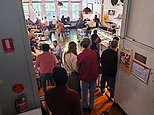
An Indian migrant has revealed Australia’s rort-riddled student visa system is regarded by others as a way to secure permanent residency – as the Albanese government prepares to cap the burgeoning number of international students.
Deep Sanghavi moved to Brisbane in 2019 to begin a master’s degree in accounting but later found himself a job as a wedding planner.
‘An Indian kid might pay around $60,000 to $90,000 just in fees to come to Australia. If you’re paying the money you should be thinking about getting the residency otherwise it’s a waste.
‘The international students pay around four or five times what the Australian kids pay… and we’ve got to pay the money upfront.’
He said he is in the process of applying for permanent residency, and plans to stay in Australia long-term.
It is not suggested that Mr Sanghavi has acted in any way improperly in relation to his obtaining a student visa to study in Australia, or in relation to his application for permanent residency.
‘I’ve studied accounting, but I’m not working in that field so I’m going to do something related which helps me out for my residency,’ he said.
While international students, and migrants more generally, are blamed for pushing up the prices of homes and rents to stratospheric levels, Mr Sanghavi argues their arrival is actually good for Australia.
‘The major contributors to the Australian economy are the international students,’ he explained.
The main piece of advice Mr Sanghavi would give new Indian migrants looking at making the move would be to focus on their studies and doing what they need to get permanent residency.
Deep Sanghavi moved to Brisbane in 2019 to begin a master’s degree in accounting but later found himself a job as a wedding planner.
As of June 2022, there were 753,520 people born in India living in Australia, which is more than double the number recorded in 2012, with many gaining entry through the student visa system. Pictured: Indians in Sydney
Regardless of the high price of accommodation, Indian migrants continue to be wooed by Australia’s high wages.
‘The pay is definitely better, that’s why everyone’s out here I feel,’ Mr Sanghavi said.
‘Because if you do the same kind of work back home you don’t get paid good money.’
The federal government in August announced it would set a cap of 270,000 international students, in a bid to stop the widespread rorting of the international education system.
It also has enhanced powers to suspend high-risk education providers.
Known as ‘ghost colleges’ and ‘visa factories’, the providers can be issued with warning notices and given six months to improve their practices.
If they fail to do so, the providers will be suspended from recruiting international students.
International student enrolments have jumped from just over 520,000 to more than 810,000 in the past two years which has resulted in shonky education providers trying to ‘make a quick buck’ by gaming the system, Jason Clare said.
‘That growth … has lured people who really are here to work, not study,’ Mr Clare told the Australian Financial Review’s higher education summit.
‘It’s put the reputation of this industry under pressure, that’s a fact,’ Mr Clare said.
Almost 150 tertiary colleges have already been shut down for failing to show proof they were offering any training to students, while warnings had been given to a further 140 so-called ‘ghost colleges’.
In one instance, a college had not delivered any training or assessments for students since 2020.
Skills Minister Andrew Giles said colleges that had not been operating for the purposes of providing quality education had been weeded out and shut down.
‘The Albanese government is calling time on the rorts and loopholes that have plagued the VET sector for far too long,’ he said.
‘Under our government, there is no place for anyone who seeks to undermine the sector and exploit students.’







